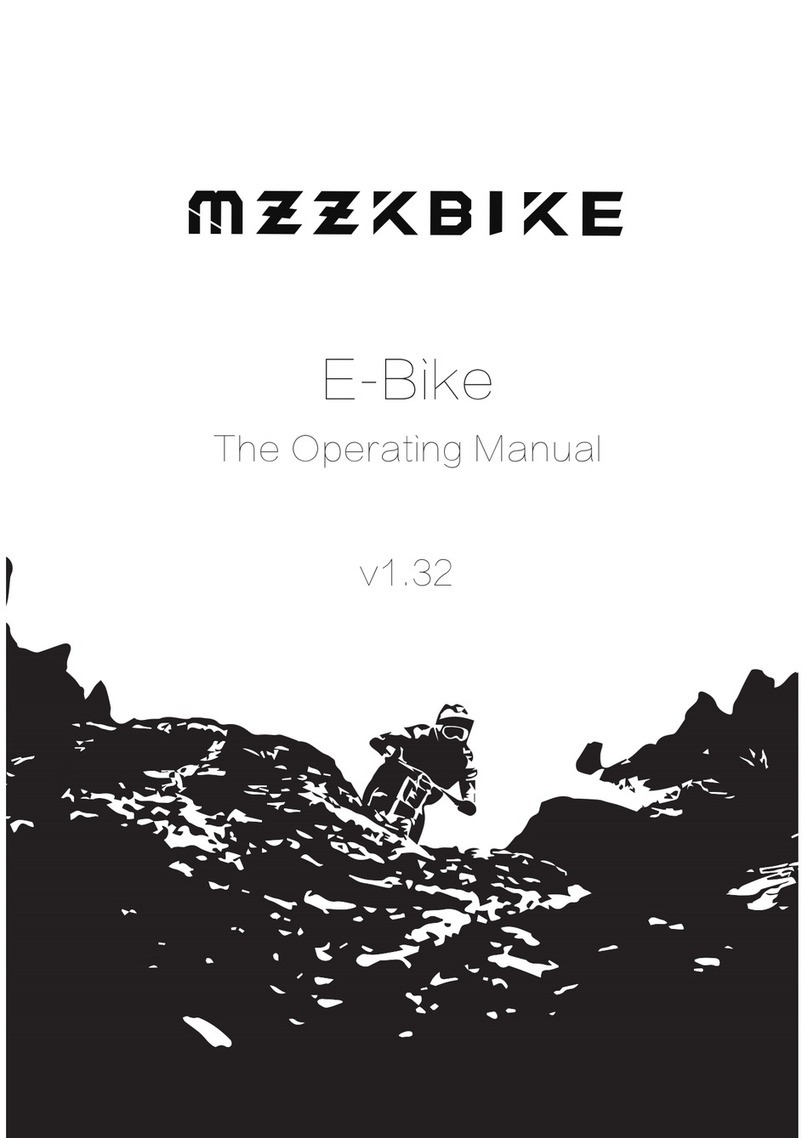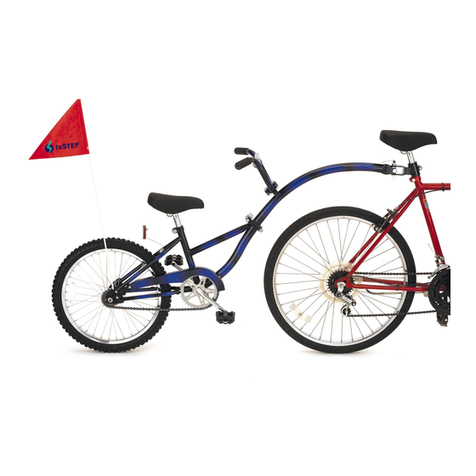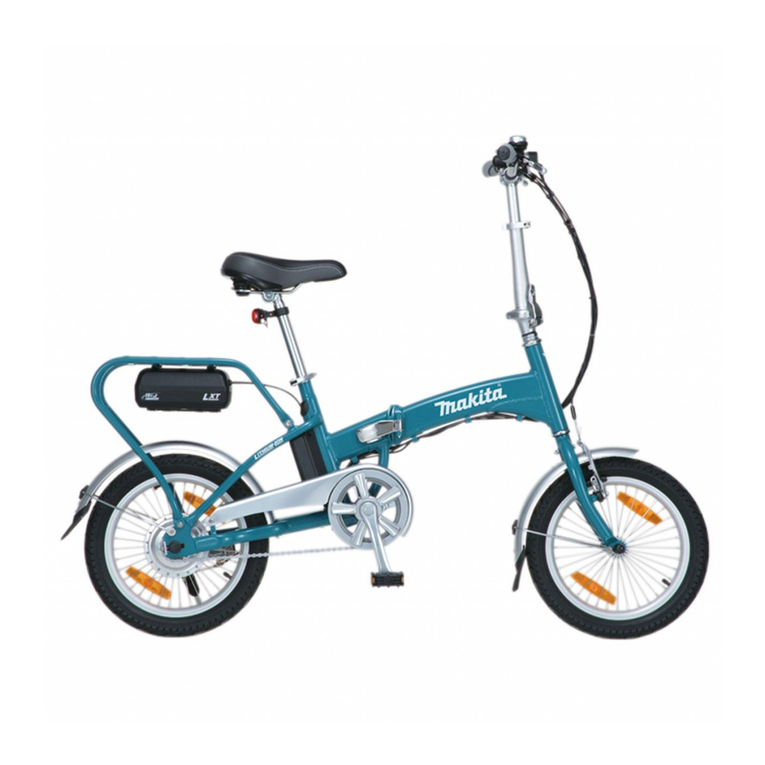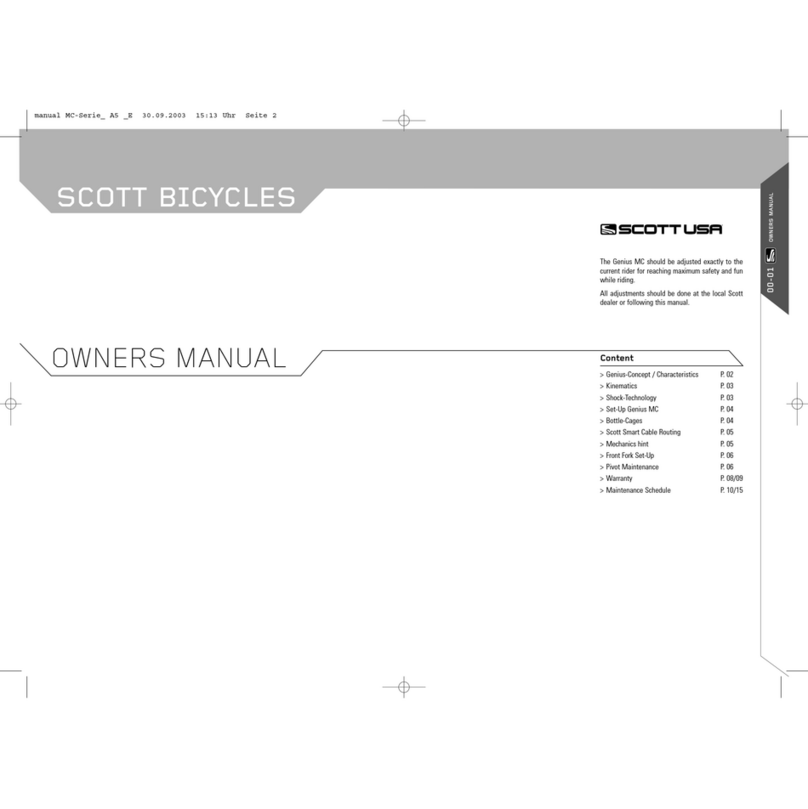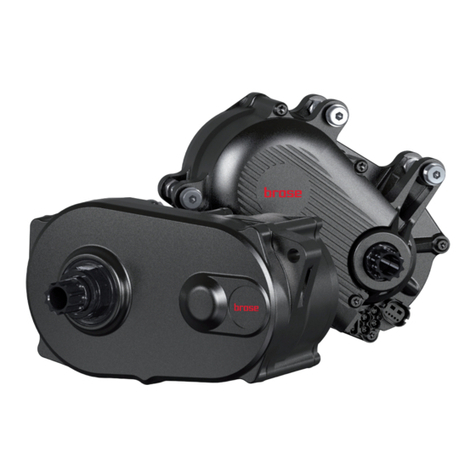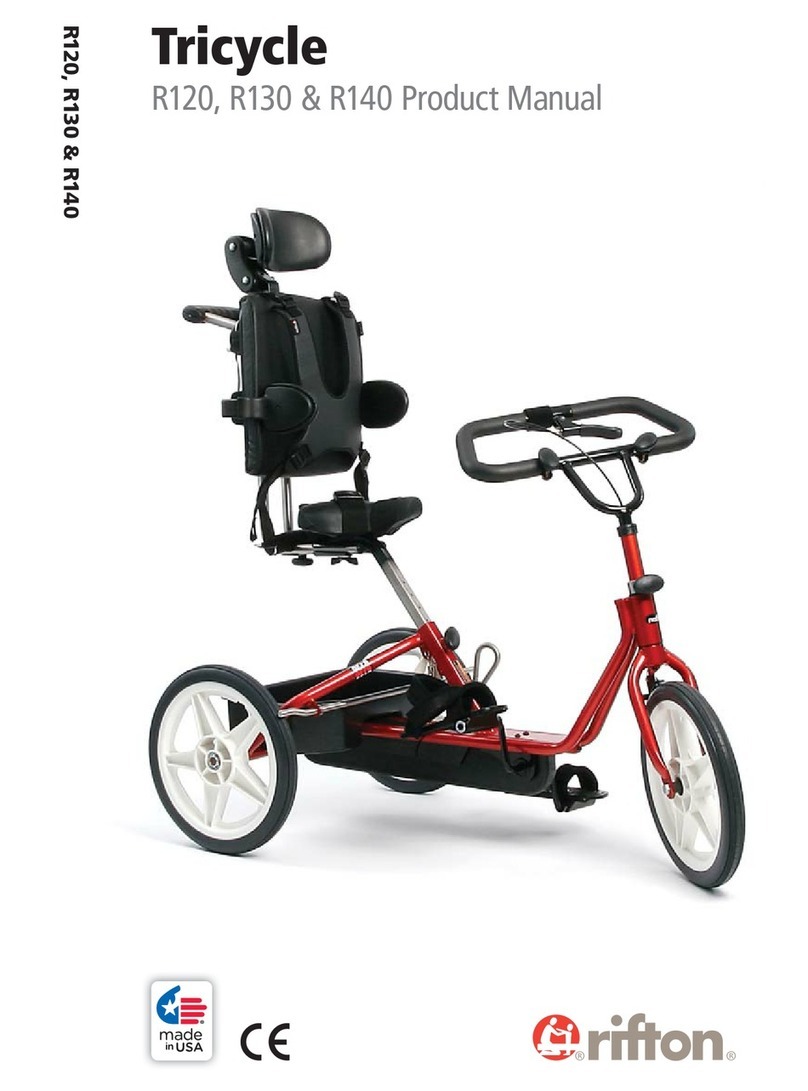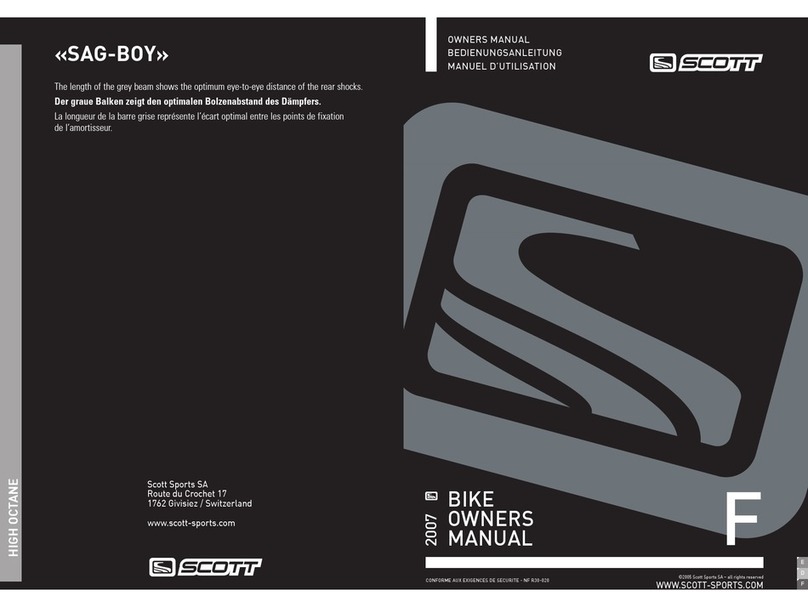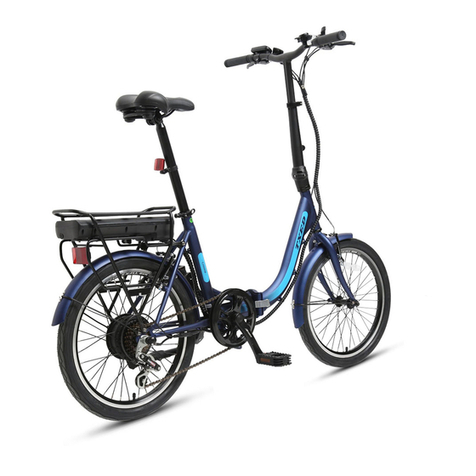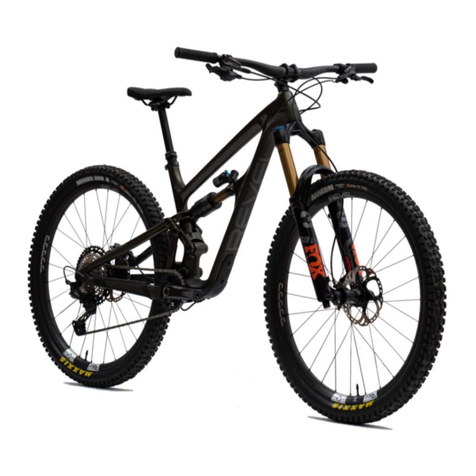MZZKBIKE LEOPARD User manual

E-Bike
The Operating Manual
2345
6 7 8 9 10 11
12 13 14 15 16 17
18 19 20 21 22 23
24 25 26 27 28 29
30

General Instructions…………………………………………………………..……………….....................2
1.Introduction……………………………………………………………………………………...................3
A.How to choose the right e-bike……………………………………………….……………..…...........3
B.General Safety Instructions…………………………………………………..……………....….........3
C.Safety information for checking the parts of bike…………………………………………....….......3
D.Important points for the first ride…………………………………………….…………….…….........4
2.Safety Information…………………………………………………………….…………………...............5
A.General Instruction………………………………………………………….......................................5
B.Important points for safe cycling…………………………………………..........................…...........6
C.Safety Information…………………………………………………………..............................….......7
D.Cycling in the rain…………………………………………………………..........................…...........8
E.Cycling at night……………………………………………………………..............................…........8
F.Cycling at night………………………………………………………………………....……......….......8
G.Extreme-, Art-, or Competitive cycling………………………………………………………..............9
3.Select the appropriate e-bike………………………………………………………………….................10
A.The crossing height (Frame Height) …………………………………………………………............10
B.The saddle height (Seat Position)……………………………………………..................................10
C.Adjust the handlebar …………………………………………………………......................……......10
D.Distance from brake bar to handlebar……………………………………..........................…….....10
4.Your e-bike (see 4 versions) ……………………………………………..........................……....….....11
A.Folding bike1………….…………………………………………………..............................……......11
B.Folding bike2.…….………………………………………………………..............................……......11
C.City bike1..……………………………………………………………..............................………........11
D.City bike2……..………………………………………………………..............................………........11
E.Mountain bike……….………………………………….......................................................……......11
F.Fat bike………………….………………………..................................................................……......11
5.Installation………………………………....................................................................…………..........12
A. Front wheel installation……………....................................................................…………..........12
B. Handlebar of installation…………......................................................................…………..........13
C. Pedals of installation…………...........................................................................…………..........14
D. Seat posts of installation…………....................................................................…………...........15
6.Battery………………………………………….......................................................................…….....15
A. The activation of the electrical system….......................................................................…….....16
B.Install and remove the battery...…......................................................................…….................17
C.Battery charging...….......................................................................…….....................................18
D. Battery life...….......................................................................…….............................................18
E. Battery safety tips..….......................................................................……...................................19
7.Display……………………………………..................................................................…………..........20
Display A instruction...……………..................................................................…………..................20
Display B instruction...……………..................................................................…………..................22
Display C instruction...……………..................................................................………….................24
8.Folding...……………..................................................................………….......................................26
9.Technical information gears……………………………………………………….............………..........26
A.Gears fixing method………………………………………………………........................………......26
10.Technical information base pulley…………………………………………………....…………...….....28
11.Wheels and hose………………………………….................................................……...………......28
A.Wheel inflation pressure…………………………………………..................…………...……….......28
12.Fall with the e-bike…………………..............................................………………....……………......28
13.Over loading……………………….......................................................……………....…………......28
14.Legal responsibility…………………………………………………………...........................…….......29
15.Guarantee…………………………………………………………………………………...………........29
16. maintenance specifications……………………………………………………...............................…30
The manual contains all the important information for a safe trip. Please read the
complete operating manual before the first ride.
Content
2345
6 7 8 9 10 11
12 13 14 15 16 17
18 19 20 21 22 23
24 25 26 27 28 29
30
minor mistakes in it.

General Instructions…………………………………………………………..……………….....................2
1.Introduction……………………………………………………………………………………...................3
A.How to choose the right e-bike……………………………………………….……………..…...........3
B.General Safety Instructions…………………………………………………..……………....….........3
C.Safety information for checking the parts of bike…………………………………………....….......3
D.Important points for the first ride…………………………………………….…………….…….........4
2.Safety Information…………………………………………………………….…………………...............5
A.General Instruction………………………………………………………….......................................5
B.Important points for safe cycling…………………………………………..........................…...........6
C.Safety Information…………………………………………………………..............................….......7
D.Cycling in the rain…………………………………………………………..........................…...........8
E.Cycling at night……………………………………………………………..............................…........8
F.Cycling at night………………………………………………………………………....……......….......8
G.Extreme-, Art-, or Competitive cycling………………………………………………………..............9
3.Select the appropriate e-bike………………………………………………………………….................10
A.The crossing height (Frame Height) …………………………………………………………............10
B.The saddle height (Seat Position)……………………………………………..................................10
C.Adjust the handlebar …………………………………………………………......................……......10
D.Distance from brake bar to handlebar……………………………………..........................…….....10
4.Your e-bike (see 4 versions) ……………………………………………..........................……....….....11
A.Folding bike1………….…………………………………………………..............................……......11
B.Folding bike2.…….………………………………………………………..............................……......11
C.City bike1..……………………………………………………………..............................………........11
D.City bike2……..………………………………………………………..............................………........11
E.Mountain bike……….………………………………….......................................................……......11
F.Fat bike………………….………………………..................................................................……......11
5.Installation………………………………....................................................................…………..........12
A. Front wheel installation……………....................................................................…………..........12
B. Handlebar of installation…………......................................................................…………..........13
C. Pedals of installation…………...........................................................................…………..........14
D. Seat posts of installation…………....................................................................…………...........15
6.Battery………………………………………….......................................................................…….....15
A. The activation of the electrical system….......................................................................…….....16
B.Install and remove the battery...…......................................................................…….................17
C.Battery charging...….......................................................................…….....................................18
D. Battery life...….......................................................................…….............................................18
E. Battery safety tips..….......................................................................……...................................19
7.Display……………………………………..................................................................…………..........20
Display A instruction...……………..................................................................…………..................20
Display B instruction...……………..................................................................…………..................22
Display C instruction...……………..................................................................………….................24
8.Folding...……………..................................................................………….......................................26
9.Technical information gears……………………………………………………….............………..........26
A.Gears fixing method………………………………………………………........................………......26
10.Technical information base pulley…………………………………………………....…………...….....28
11.Wheels and hose………………………………….................................................……...………......28
A.Wheel inflation pressure…………………………………………..................…………...……….......28
12.Fall with the e-bike…………………..............................................………………....……………......28
13.Over loading……………………….......................................................……………....…………......28
14.Legal responsibility…………………………………………………………...........................…….......29
15.Guarantee…………………………………………………………………………………...………........29
16. maintenance specifications……………………………………………………...............................…30
Applies to EN 14764, 15194
Important Information:
The manual contains all the important information for a safe trip. Please read the complete
operating manual before the first ride.
If you have any questions or uncertainties, please contact a dealer. The operating manual has
been carefully checked. Nevertheless, we hope you can understand that might have several
DANGER
The signal word indicates a hazard with a high risk grade, if not avoided, results in death or a
serious injury.
WARNING
The signal word indicates a hazard with a medium risk grade which, if not avoided, can result
in death or a serious injury.
CAUTION
The signal word indicates a hazard with a low risk grade, if not avoided, can result in a minor
or moderate injury.
The e-bike driver assumes full responsibility for unforeseen and inevitable risks during the
operation.
!
!
!
2 3 4 5
6 7 8 9 10 11
12 13 14 15 16 17
18 19 20 21 22 23
24 25 26 27 28 29
30
General instruction
Like any sport, there is also an e-bike risk of injury and damage. If you opt for an e-bike, you
take the risk. Therefore, you must acquire and execute all safety rules. Using the e-bike proper-
ly can reduce the risk of injury.
Read all warnings and instructions in this operating manual carefully before using the e-bike.
This manual is an integral part of your e-bike. Always keep the operating manual close to your
e-bikes so that it is available at all times. If you give your e-bike to a third party, be sure to
include this manual.
Definition of concepts and symbols
The purpose of security symbols is to draw your attention to potential dangers. The security
symbols and their explanation require your full attention. Security symbols alone do not
prevent dangers. Failure to follow a safety notice can result in injury to your own or another
person. Therefore, always follow the safety precautions to avoid the risk of fire, electric shock
and injury.
Observe all instructions marked with signal words and symbols with the following meanings:

!
Read the operating manual carefully before you first drive. Please make sure you understand
every hint. If you have any questions or uncertainties, please contact with a dealer. This
manual does not contain all the information for each e-bike. A specialist dealer will be happy to
answer any questions that are not listed in this manual.
A. How to choose the right e-bike
1. Does your e-bike fit you? If your e-bike is too big or too small for you, you lose control and
could fall down.
2. Sit on different e-bikes gladly sample from a specialist dealer.
3. Is your seat height suitable for you? Adjust them accordingly.
4. Is the saddle fixed? The saddle should be firm.
5. How is the height for control unit and handlebar? You may need to adjust this.
6. Can you use the brake comfortably? If not, adjust the angle and distance to the handlebar.
7. Have you understood how to use your new e-bike? If not, you should contact a specialist
dealer. The dealer will clarify your questions and uncertainties.
B. General Safety Instructions
1. Before you leave, please use a suitable bike helmet. Wear and maintain your bike helmet
according to the instructions of the bicycle helmet manufacturer.
2. If you have all the safety equipment, you should learn and follow local laws and rights.
3. Do you know how to fix the gears? If the gears are not properly mounted, they will loosen,
and it can cause damage and death.
4. If you want to use different pedals, please learn how to use them. Special pedals require
special techniques to use.
5. If your bike frame is too small, it may interfere with driving. Please check the height.
6. Does your e-bike have shock absorbers? Use your shock absorbers only for the appropri-
ate application.
C. Safety information for checking the parts of bike
Please check your e-bike before driving: nuts, bolts, screws and other parts. Make sure that
all parts are correctly fixed and tightened.
Use appropriate tools such as: a nut wrench, a specialist dealer will also use such a tool. If
you are not sure, ask a dealer.
DANGER Proper tightening of nuts, bolts, screws and other parts is very important. If
there is too little or too much torque, the parts will not be properly fixed and will be damaged.
Make sure there are no loose parts. Check especially the gears, whether they are loose or not.
This can be more easily executed, before you ride the e-bike.
Wheels and gears: Make sure the wheels have the correct wheel pressure, place one hand
1. Introduction
2 3 4 5
6 7 8 9 10 11
12 13 14 15 16 17
18 19 20 21 22 23
24 25 26 27 28 29
30

on the saddle, the other hand on the control unit, then push the whole weight of the body onto
the e-bike, then note the changes of the wheels. For flat wheels, please fill the wheels with
compressed air. Is the shape of the wheels normal? Turn each wheel, and look for dents or
damage. Replace the damaged wheel.
Must the rims be repaired? Keep the rims clean. If the wheel wobbles too much or the brake
does not work properly, these parts must be serviced or replaced.
WARNING Brake pads can only work effectively when the wheels are working properly.
The adjustment of the wheels requires special tools and experience. You need professional
knowledge, experience and tools. Are the rims clean and intact?
Make sure of this. Check that the brake pads are correctly positioned when you apply the
brake. Check whether the brake pads have reached their wear limit or not.
DANGER E-bikes are subject to wear. Check whether wearing limits are visible. When
you continue using the e-bikes with worn parts, this can cause you damage and fall down.
Brake: Check whether the brake is working properly. Pull the brake lever for testing. Are all
brake lines firmly fixed? If you use a "V-Brake", check the brake pads to make sure that they
are in contact with the rim. Is the way of the brake lever still acceptable?
Quick clamp: Install the front and rear wheels quickly and safely.
Seatpost: If your seatpost has a quick clamp, make sure that it is firmly fixed.
Adjustment of handlebar and seat height: The saddle and handlebar should be aligned, tighten
the screws.
Handlebar: Make sure that the handlebars are firmly fixed. If you have any questions, please
contact with a dealer. Do not let go if you are not sure. If you have other attachments on the
handlebars, make sure that they are attached.
DANGER Loose parts can lead to accidents.
Important safety precautions:
Please read the important information about the e-bike and the service life.
D. Important points for the first ride
If you are wearing a helmet on your first ride, be sure to select an environment that is as far as
!
!
!
2 3 4 5
6 7 8 9 10 11
12 13 14 15 16 17
18 19 20 21 22 23
24 25 26 27 28 29
30

possible without cars, cyclists, obstacles or other hazards. Then practice with your e-bike. Get
familiar with the brakes. First brake slowly, so the wheels can not be blocked.
If your E-Bike has racing bike pedals or normal pedals, familiarize yourself with the use. If your
e-bike has shock absorbers, please familiarize yourself with it. How does the shock absorber
react when the driver brakes or changes his weight?
Practice with the gearshift. Please practice how the e-bike reacts or accelerates when you
have entered a certain gear. If you have any questions, please contact with your dealer before
you start.
2. Safety Information
A. General Instruction
DANGER You need a safe equipment. Keep the legal regulations and you can ride only
where it’s allowed (e.g. the bike paths in the city). Only allow the authorized people to drive the
e-bike (concern e.g. children). Please wear helmets at any time.
1. Always wear a bike helmet according to current standard.
Use and maintenance of your helmet: Always follow the manufacturer’s
instructions.
If you wear suitable helmet, then the probability of serious head injuries
will be reduced.
DANGER Not wearing a helmet can lead to serious or fatal injuries.
2. Please check your helmet before each trip.
3. Know your e-bike, e.g. brakes, pedals and gearlever.
4. To be careful, do not let your body to come into sharp objects such as bike chains, bike
pedals or wheels.
5. Necessary equipment:
Bike shoes: It is important to wear a pair of durable and light shoes. However they are light,
but light shoes with stable soles, which distribute the pedals on the whole foot. You should
know that bike shoes with clicks for a tight binding better than conventional shoes.
Jackets: Special advantages are provided by jackets, such as breathable, at the same time
wind- and waterproof. A windproof jacket is essential on a long trip.
However, a low-cost material such as rubber coated nylon impairs the natural breathing of the
body.
!
2 3 4 5
6 7 8 9 10 11
12 13 14 15 16 17
18 19 20 21 22 23
24 25 26 27 28 29
30

Shirts: Functional shirts are easy to be washed and dry quickly. This helps in the principle of
“Take a little with you and wash on the road”, which should be remembered by us when you on
bike trips. And those who do not like the sporty look of functional clothing: more and more
collections can hardly be distinguished from everyday clothes.
Trousers: Even trousers should not restrict the movement and be comfortable. With a zip
around the knees, long trousers can quickly be converted into shorts. Padded bike trousers
provide extra comfort on long trips.
Protective glasses help against dirt, dust and insects. Use different tinted lenses. If you are in
strong light use the dark lenses, if the light is weak use bright lenses.
6. Do not try to jump with the e-bike. Jump is albatross for the e-bike.
7. The faster you ride, the higher the risk of an accident you face.
B. Important points for safe cycling
1. Please follow all local traffic rules.
2. The roads are shared with other people, such as motorcyclists, pedestrians and other
cyclists. Please respect other road crew.
3. Make sure that you can be seen by cornering drivers.
4. Pay attention to the following situation:
• Cyclists should always keep sufficient distance to large vehicles such as trucks and buses. If
there is sufficient space, cyclists are allowed to overtake cars at a traffic light carefully on the
right side of the road. You can park at crossroads in front of the motor vehicles, if there is a
corresponding place which is marked. In the case of trucks and buses are not recommended
do like this. Due to the blind spot the cyclists can’t be seen. Because of the increased seating
position of the truck driver, the cyclists, which stand in front of a truck, are also hardly visible.
Particular dangerous is right-hand bend: buses and trucks usually arrange themselves on the
left side of their roadway in order to be able to drive around the corner with the rear of the
vehicle.
This formation of the road surface seems to be through, in the process of turning, this blind
area is also expanding. This is fatal for the cyclist, who has no room to evade.
For safety reasons cyclists should always stay behind buses or trucks and pay attention to their
turn signals.
2345
6 7 8 9 10 11
12 13 14 15 16 17
18 19 20 21 22 23
24 25 26 27 28 29
30

• Opening car doors.
• People who come out of the sidewalk.
• Children or pets playing next to the street.
• Sewers, drains, railway rails, gaps, road or sidewalk construction, dirt and other obstacles
can cause a cyclist to fall.
• Do not be distracted.
5. Please drive with the bike on the marked bike paths or some paths which are on the edge of
the road, along the traffic. Pay attention of the correct direction of travel.
6. Stop at the parking signs, traffic lights and the crossings. The cyclists are always injured
more severe than a driver in an accident.
7. Use your hand as a signal when turning.
8. Do not wear earphones during cycling, as you will not be able to hear the ambulance. In
addition, the cable can wrap around bike parts, after that you will lose control.
9. Children should only be placed on suitable seats or wear the helmet.
10. Don’t bring anything to hinder your cycling.
11. Don’t hang on vehicle such as trams or buses
12. Don’t try to trick. You should be aware of the risks.
13. Don’t frighten any other drivers.
14. Observe vehicle traffic at all times.
15. Under the influence of alcohol or drugs, you must not ride the bike.
16. In the following cases, you should avoid driving: bad weather, poor visibility, dusk or in the
dark or extreme fatigue. Each case will increase the risk of accidents.
C. Safety Information
Children can only take an off-road trip under the supervision of adults.
1. The danger of the off-road trip and the result of the unpredictable environment require a high
degree of attention and special abilities from the driver. First, practice on a flat terrain and learn
to drive safely in the field.
2. Wear suitable protective equipment.
3. Do not drive alone in the remote areas. Share your trip with your friends and tell them when
you will go back home.
4. Always carry your identification, so that in case of an accident and the others will know who
you are. Take some money, food, drink and a mobile phone to be able to make an emergency
call.
5. Take consideration for the others.
6. Prepare your off-road trip well; in case of emergency, because you are on your own.
7. Before you jump from your e-bike, you should be aware of these risks.
2345
67 8 9 10 11
12 13 14 15 16 17
18 19 20 21 22 23
24 25 26 27 28 29
30

!
!
!
!
Off-road driving
Please observe the local laws and the rules, also observe private property of others. Respect
other people, animals, the environment and the ecosystem.
Don’t leave any rubbish.
D. Cycling in the rain
DANGER Rain makes the ground slippery and increases the likelihood of a traffic accident.
Please adjust your speed.
E. Cycling at night
Cycling at night is more dangerous than daytime. Drivers and the pedestrians can’t easily see
the cyclists at night. Therefore, children should not drive at dusk or at night.
Adults who want to ride at dusk or at night should have an increased attention.
DANGER Taillight are not a substitute for the necessary lighting at night. Cycling at dawn,
dust, night or other bad viewing conditions are very dangerous if you do not have a sufficient
lighting system and no reflector on your bike. It could result in serious injury. A reflector on the
bike can reflect the light of cars and street lamps. By this way they can see very clearly.
WARNING Check regularly the reflector and its fixing. It must be clean, vertical, unbroken
and properly installed. You can let your dealer to replace the broken reflectors.
DANGER Don not remove the front and rear reflectors from your bike. These parts are
indispensable parts of the e-bikes. Without the reflectors the drivers or pedestrians can’t see
you on the road. It could lead to serious injury even death.
If you are driving in bad viewing conditions, please check the local regulations for night driving.
For this, you should take additional measures:
• In order to meet the requirements of cycling and a sufficient visibility, you should use the
appropriate lighting for your e-bike.
• Wear bright and reflective clothing and equipment, such as reflective vest, reflective tape on
arm and leg and so on.
• Ensure that your clothes don’t block the reflectors or lights.
• Ensure that the install position of the lights is not a hidden danger.
F. Cycling at night
• Drive slowly.
• Avoid the dark areas and traffic jams.
2345
678 9 10 11
12 13 14 15 16 17
18 19 20 21 22 23
24 25 26 27 28 29
30

!
• Pay attention to pavement damage.
• If it’s possible, drive in the route, which you know very well.
Make sure you have an approved lighting when you are driving in public traffic. We assume no
liability for inadequate lighting. Our e-bikes are delivered as offered. Depending on the
location, you may have to retrofit the lighting.
Driving in heavy traffic areas:
• To be proactive. So that other drivers can see your bike and your next stop. Caution: the blind
angle.
• To be alert.
G. Extreme-, Art-, or Competitive cycling
If you are doing extreme driving with your e-bike, the risk of injury will increase or lead to death.
Not all wheels are suitable for this kind of cycling. Ask your dealer which e-bike is suitable for
the extreme sports.
With an e-bike you can easily reach the speed of a motorcycle. Let a qualified mechanic to
check your bike and equipment to make sure that these work properly. Wear suitable protective
equipment, including an integral helmet, gloves and body protectors. In short, you have
responsible to wear the appropriate equipment and be familiar with the driving conditions too.
Know your limits and always wear a helmet and the appropriate protective equipment.
WARNING Bikes and the parts of the bikes have their limits. Don’t exceed this limit. We
recommend the following:
•Take part in a driving training.
• Before you take higher risks increase your abilities.
• Only drive in prescriptive areas.
• Wear integral helmet, body protectors and other protective clothing.
• Overloading is not covered by the warranty or in the defects liability period.
2345
6789 10 11
12 13 14 15 16 17
18 19 20 21 22 23
24 25 26 27 28 29
30

!
!
!
3. Select the appropriate e-bike
Note: choose a suitable e-bike is an important factor. Adapt your vehicle to your body propor-
tions. Use the experience of a specialist dealer.
WARNING An e-bike that does not fit you can lead to fall down
C. Adjust the handlebar grips
Adjust the gradient of the handlebar so that your hands can comfortably engage the handles.
The tooth must interlock correctly so that the saddle is firmly attached.
D. Distance from brake bar to handlebar
Some bike models have adjustable brake levers. If your hands are small or it is difficult to
operate the brake handles, use a smaller brake lever.
DANGER Make sure that you can operate the brake levers correctly, otherwise it may
cause serious injury or death.
A. The crossing height (Frame Height)
1.The Frame
Evaluate the distance from the ground to your step and then
find the appropriate frame size.
B. The saddle height (Seat Position)
A comfortable saddle is indispensable, if the position of the
saddle is not comfortable enough for you, you should adjust
it accordingly. To adjust the saddle height: If a pedal is down,
the leg should be ideally stretched.
Set the best position to achieve the ideal seat position.
See the follow order to adjustment:
1. Loosen the saddle clamp
2.Lift or lower the saddle
3.The seat cushion should be straight ahead
4.Tighten the saddle clamp with suitable torque
WARNING The saddle clamp can break during travel
when you pull it out too far.
5. Also adjust the gradient and position of the saddle. The
tooth must interlock correctly so that the saddle is firmly
attached.
2345
678910 11
12 13 14 15 16 17
18 19 20 21 22 23
24 25 26 27 28 29
30

Weight: 23kg (incl. battery 2kg)
Payload (incl. driver and load): ≤120kg battery
Voltage: 48V
Engine power: 48V250W
Highest speed: 28km/h
Loading time: 3-5h (2A)
Range: 7.5AH Depending support 50-80km
Weight: 27kg (incl. battery 3kg)
Payload (incl. driver and load): ≤120kg battery
Voltage: 48V
Engine power: 48V750W
Highest speed: 40km/h
Loading time: 4-6h (2A)
Range: 12.5AH Depending support 80-120km
Weight: 29kg (incl. battery 3kg)
Payload (incl. driver and load): ≤120kg battery
Voltage: 48V
Engine power: 48V500W
Highest speed: 38km/h
Loading time: 4-6h (2A)
Range: 12.5AH Depending support 80-120km
A. LEOPARD
B. COMET
C. FALCON
2345
6 7 8 9 10 11
12 13 14 15 16 17
18 19 20 21 22 23
24 25 26 27 28 29
30
4. Your e-bike
Your EBike may not be pictured below, however, check www.ebikeedmonton.com for a
description of your make and model.
*Using different capacity battery, the maximum range and charging time will be different, Battery
charging time will be different if you use different charger.

!
5. Installation
A. Front wheel installation
Before doing so, make sure that all the individual parts of the axle are positioned correctly,
especially the rendelnut and the springs.
See the photo. When inserting the front wheel into the fork, make sure that it is correctly seated
in the guides and that the brake disc is correctly seated between the two brake pads. Now you
can insert the axle through the wheel hub. Make sure again that all the small parts of the axle
are seated correctly, see the photo. If you tighten the rendelnut lightly up, make sure one more
time that all parts are seated properly. Now move the quick clamp lever to make the bike fixed.
After turning the lever, the power expenditure in moving the lever and the final strength must
be so strong that the front wheel is correctly fixed.
DANGER
If you are not sure about how to properly fasten the front wheel, be sure to ask a dealer,
otherwise it is possible that you will be incorrectly installed and you are not safely driving with
the e-bike. Incorrect installation may result in injury and/or death.
2345
6 7 8 9 10 11
12 13 14 15 16 17
18 19 20 21 22 23
24 25 26 27 28 29
30
A
1
2
3
Lock
1

2345
6 7 8 9 10 11
12 13 14 15 16 17
18 19 20 21 22 23
24 25 26 27 28 29
30
Lock
Handlebar A
B
!
B. Handlebar of installation
When you install the handlebars, make sure that the front part is inserted completely. See the
photo with arrows. Do not lose any balls of the bearing. Insert the sleeves flush and tighten
all the set screws.
DANGER
If you are not sure about how to properly fasten the handlebar and/or parts of handlebar, be
sure to ask a dealer, otherwise it is possible that you will be incorrectly installed and you are
not safely driving with the e-bike. Incorrect installation may result in injury and/or death.

2345
6 7 8 9 10 11
12 13 14 15 16 17
18 19 20 21 22 23
24 25 26 27 28 29
30
C. Pedals of installation
There is a left pedal and a right pedal with its own thread. For the purpose of mounting,
simply turn the each symmetrical pedal with the thread into the foot crank. Please be careful
to avoid damaging the thread. Then tighten with a suitable tool.
Handlebar B
Handlebar C
THXAM

2345
6 7 8 9 10 11
12 13 14 15 16 17
18 19 20 21 22 23
24 25 26 27 28 29
30
!
D. Seat posts of installation
Slide the seat posts into the seat pipe. Make sure that you will not pull the seat posts any
more until the "MAX" mark, otherwise you will not have sufficient attachment. Gently tighten
the rendelscrew. Now move the quick clamp lever to make the seat posts fixed. See the
photo. After turning the lever, the power expenditure in moving the lever and the final strength
must be so strong that the seat post is correctly fixed.
DANGER
If you are not sure about how to properly fasten the seat posts, be sure to ask a dealer,
otherwise it is possible that you will be incorrectly installed and you are not safely driving with
the e-bike. Incorrect installation may result in injury and/or death.
MAX
Open
Lock
!
DANGER
If you are not sure about how to properly fasten the pedals, be sure to ask a dealer,
otherwise it is possible that you will be incorrectly installed and you are not safely driving with
the e-bike. Incorrect installation may result in injury and/or death.

6.Battery
Battery A Battery B
Battery C
A. The activation of the electrical system
Before cycling, make sure you open the switch on the side of the battery (see below, battery A
doesn't need to switch). Then open the display mounted on the handle bar. Select the assist
state you need and pedal. When you pedal, you'll find that the engine starts. When you use the
brakes, the power of the brakes will stop the motor immediately. By turning off the power, you
can also use the bike (turn off the power or switch to 0) without the help of the battery. The
motor is in a zero resistance state: you can ride freely.
Your bike battery may have a reset button to reset the battery in the event of no power.
ON
PUSH
OFF
Battery B Battery C
2345
6 7 8 9 10 11
12 13 14 15 16 17
18 19 20 21 22 23
24 25 26 27 28 29
30

Battery A
ON
PUSH
OFF
B.Install and remove the battery
Before removing the battery, open the lock along the battery box and pull the battery down.
When installing the battery, insert the battery into the guide rail, close up and attach to the
controller box, push the battery, and lock the lock (see image below)
Battery B
Battery C
ON
PUSH
OFF
2345
6 7 8 9 10 11
12 13 14 15 16 17
18 19 20 21 22 23
24 25 26 27 28 29
30

C.Battery charging
When you connect it to the battery charger socket, the charger shows a green or red light,
whether the battery is charging (red) or is already fully charged (green). Depending on the
model, the battery can be removed from the battery compartment.
D. Battery life
The range of the e-bikes is 40-100 km. The battery backup time depends on the following
factors: frequency of use of the battery, load, frequency of braking / start-up, wheel pressure,
etc.).
Bike batteries work like household batteries. When the battery reaches the end of life, you must
buy a new battery from your dealer.
If you do not use the battery for more than two months, place the battery in a dry place to protect
the battery components. Ensure that the battery is never fully charged or completely discharged.
CAUTION Do not store a battery that is not fully discharged, as this would result in perma-
nent damage. In winter or during a long term storage process, it is recommended to charge the
battery every half month. Do not forget to turn off the battery. Store your battery at a temperature
better between 15 ° C and 25 ° C.
1. The display indicates when the battery is low and it should be charged immediately. A timely
charge will extend the life of the battery. The battery should be charged for about 3-6 hours. The
life expectancy of the battery is thus extended enormously. Otherwise the life expectancy of the
battery will be shortened and in the worst case the battery will be broken.
2. If you are driving on a slope with electrical support, first you should accelerate gently to keep
the low load and avoid components burning.
3. If the battery for a longer period not in use, it should be charged every two months.
4. When charging, please provide sufficient ventilation in the room to avoid the explosion。
5. The battery works best at a temperature of 15 ° C – 40 °c. Outside this temperature range, the
battery will not operate without interference.
6. Avoid the danger of short circuits.
7. The battery is a special battery for e-bikes. Please do not let other consumers to use your
!
2345
6 7 8 9 10 11
12 13 14 15 16 17
18 19 20 21 22 23
24 25 26 27 28 29
30

power source. Therefore you can avoid damaging the battery.
8. Do not use organic solvents to clean the battery jar.
Do not use carbon dioxide fire extinguishers to put out a fire. Fire extinguishers should contain
carbon or something like this.
9. For repairs or maintenance, please use authorized places to avoid environmental pollution.
10. At an ambient temperature above 40 °c or under-10 ° C, the battery life is shortened. Avoid
direct sunlight during summer. In winter, the battery should be stored and charged in a hall. After
the battery is fully charged, it should take two hours longer.
E. Battery safety tips
The battery contains electronic components with chemical elements. For your own safety,
please consider the following provisions:
1. Handle the battery carefully
2. Place all electronic devices out of the reach of children. Do not damage, do not open, protect
from wetness.
3. Do not expose temperatures above 60°
4. The battery should not get in contact with the floor as far as possible.
5. Do not load when you are in absence.
6. Do not sleep near a charging battery.
7. Charging only with an original charger. Do not touch defective batteries.
2345
6 7 8 9 10 11
12 13 14 15 16 17
18 19 20 21 22 23
24 25 26 27 28 29
30
This manual suits for next models
2
Table of contents
Other MZZKBIKE Bicycle manuals
